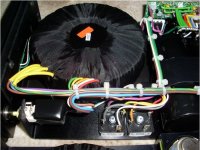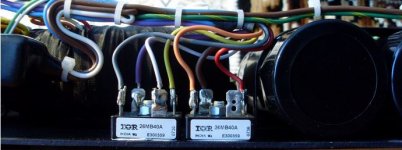🙂 Similar with the real F3. Yes, the FREDs are about the best. Paralleling will reduce current and improve performance of the diodes.
Naim do not put film caps in parallel with their electrolytics nor rectifier diodes. Why not?I believe that apart from the careful dimensioning in terms of Power and Capacity, the goodness of a power supply stage is all about the quality of the electrolytic filtering capacitors (always paralleled with a plastic film and/or polypropylene capacitor to compensate for the parasitic inductance) and even more with rectification diodes.
Member
Joined 2009
Paid Member
Naim do not put film caps in parallel with their electrolytics nor rectifier diodes. Why not?
What diodes did Naim use? I think the BYW51 is not good without snubbers. Best is using suitable diodes without snubbers.
GOOOd question !! I had never thought about it !Naim do not put film caps in parallel with their electrolytics nor rectifier diodes. Why not?
before assembling (in the right way) my first naim clone, on all my other amp, I tended to mount the diode bridge directly on the capacitor or as close as possible.
that's what I did with my first clone and what
I started it, I had buzz in the hp.
So I took the exact implementation naim without changing the components and my amp and became one of the quietest I've had in my life.
since, as you can do when you assemble a tube amp, I assemble the power supply with temporary wire and I move the elements to get the perfect calm.
I am aware that some topology and some operating class are more sensitive than others but since then, I have no problem buzz.
that's what I did with my first clone and what
I started it, I had buzz in the hp.
So I took the exact implementation naim without changing the components and my amp and became one of the quietest I've had in my life.
since, as you can do when you assemble a tube amp, I assemble the power supply with temporary wire and I move the elements to get the perfect calm.
I am aware that some topology and some operating class are more sensitive than others but since then, I have no problem buzz.
It is worth paying attention to how the diode bridge supplying the preamp circuits is turned on: two diodes are used - a rectifier with a midpoint.
May be. But on this site I found exactly the same approach when turning on the rectifier bridge to power the pre-amplification circuits. And in my clone it was done as well. http://tech.juaneda.com/en/articles/articles.html
http://tech.juaneda.com/en/index.html
( The link for some reason becomes non-working ...? )
Here are the literal words of the person who posted the photo: "Rectifier bridges. I have already said on this forum that not all 4 diodes are used to power the preamplifiers, but only two."
http://tech.juaneda.com/en/index.html
( The link for some reason becomes non-working ...? )
Here are the literal words of the person who posted the photo: "Rectifier bridges. I have already said on this forum that not all 4 diodes are used to power the preamplifiers, but only two."
Last edited:
Cuts the link to High End Audio - Home Page. In the "Articles" section there are interesting moments from experiments on the organization of the connection LM317(Capacitor selection) . And like (two diode) inclusion of rectifier bridges.
Last edited:
It is worth paying attention to how the diode bridge supplying the preamp circuits is turned on: two diodes are used - a rectifier with a midpoint.
Try 1 diode!
Yes, the magic of sound from a half-cycle rectifier is very often discussed in tube themes. But, to this approach, I am still morally unprepared.🙂
- Home
- Amplifiers
- Solid State
- NAP-140 Clone Amp Kit on eBay

